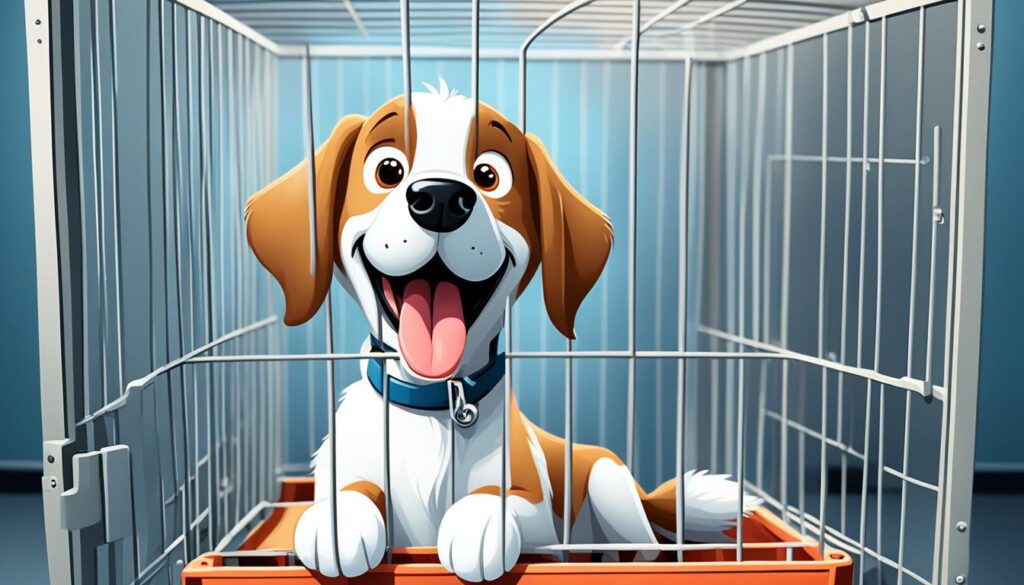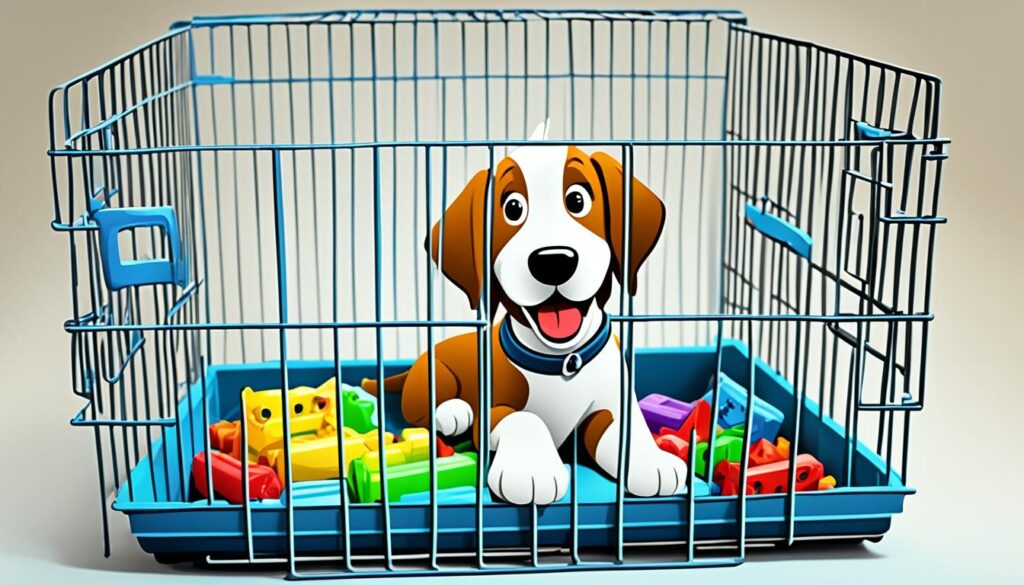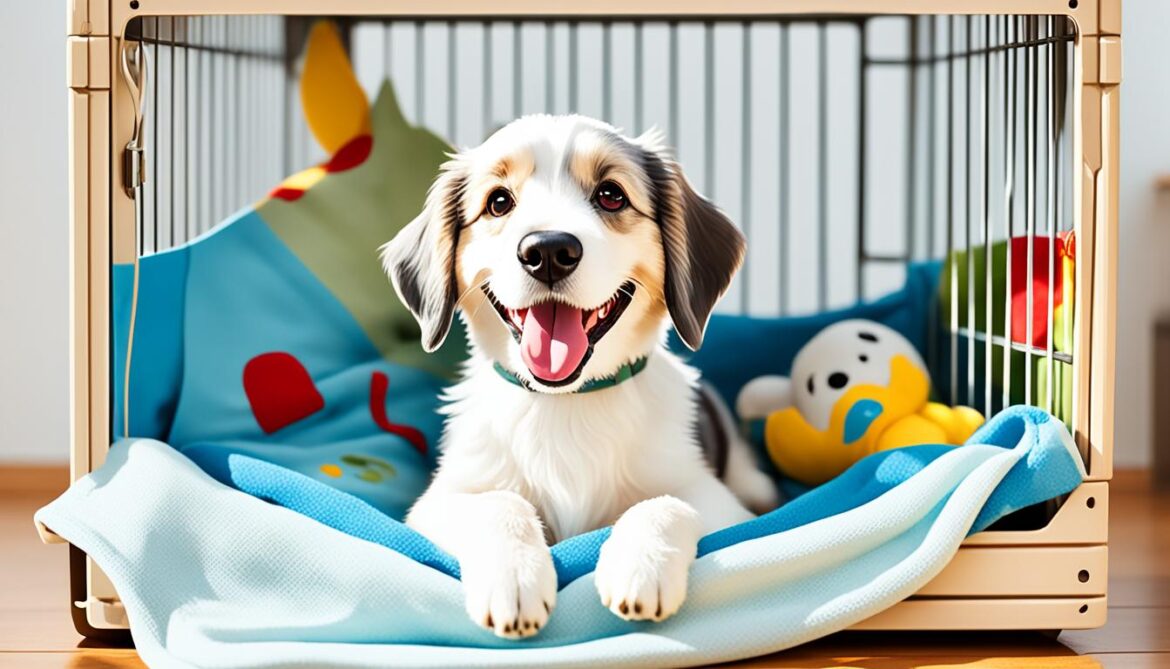Imagine coming home to find your new puppy chewing on your favorite pair of shoes, or your older dog making a mess of your living room while you were at work. Frustration sets in, and you wonder how you can prevent these accidents and destructive behaviors.
That’s where crate training comes in. It’s not about confining your furry friend, but creating a safe and comfortable space where they can feel secure and learn good behaviors. Whether you have a new puppy or an older dog, crate training is a valuable tool that can offer numerous benefits.
Learning how to crate train your dog will not only provide your pet with a cozy den-like environment, but also aid in house training and prevent destructive behaviors. It’s a win-win for both you and your furry companion.
Key Takeaways:
- Creating a safe and comfortable space for your dog through crate training
- Aiding in house training and preventing destructive behaviors
- Benefits of crate training for puppies and older dogs
- Expert tips and techniques for successful crate training
Why Crate Train Your Dog
Before diving into the specifics of crate training, it’s important to understand the benefits it can offer. Crate training provides a den-like environment for your dog, offering a sense of security and comfort. It can also help prevent destructive behavior, as dogs often feel less anxious and more relaxed in their crates. Additionally, crate training can aid in house training by teaching your dog to hold their bladder and bowel movements.
To better understand the numerous benefits of crate training, let’s take a closer look at why it is such a valuable tool for dog owners:
- Security and Comfort: Dogs are naturally den animals, and crates mimic this instinctual behavior. By providing your dog with a crate, you’re giving them a safe and cozy space where they can retreat to and feel secure.
- Prevent Destructive Behavior: Dogs may engage in destructive behavior when they are bored, anxious, or not properly supervised. Crate training can help prevent this by giving your dog a designated space where they can relax and be less prone to destructive behaviors like chewing on furniture or excessive barking.
- Aid in House Training: Crate training plays a crucial role in house training your dog. Dogs naturally avoid soiling their living spaces, and crate training can help teach them to hold their bladder and bowel movements until they are outside. This promotes better house training and helps establish good bathroom habits.
- Safe Transportation: Crates are also invaluable when it comes to transporting your dog, whether it’s for a vet visit or a family road trip. A properly crate-trained dog will feel comfortable and secure during travel, reducing stress and ensuring their safety.
Here is a table summarizing the benefits of crate training:
| Benefits of Crate Training |
|---|
| Provides a den-like environment for security and comfort |
| Prevents destructive behavior |
| Aids in house training |
| Facilitates safe transportation |
By understanding the benefits of crate training, you can make an informed decision about whether it is the right approach for you and your canine companion. In the next section, we will discuss how to choose the right crate for your dog.
Choosing the Right Crate
The key to successful crate training lies in selecting the right crate for your dog. Consider the size and breed of your dog when choosing between wire crates, plastic crates, or soft-sided crates. Ensure that the crate is large enough for your dog to stand up, turn around, and lie down comfortably. For puppies, opt for crates with dividers to accommodate their growing size.
When choosing a crate, keep in mind that it should be a safe and comfortable space for your dog. Wire crates provide excellent ventilation and visibility, making them suitable for dogs who may feel anxious or claustrophobic. Plastic crates, on the other hand, offer a cozy and den-like environment that can help your dog feel secure.
Tip: If your dog tends to chew on things, consider a wire crate with a durable metal construction to prevent them from damaging the crate.
Soft-sided crates are lightweight and portable, making them ideal for travel or for dogs who need a crate in multiple locations. However, they may not offer the same level of durability as wire or plastic crates.
When introducing your puppy or adult dog to their new crate, it’s important to create a positive experience. Place soft bedding, familiar toys, and treats inside the crate to entice your dog to enter. This will help them associate the crate with positive rewards and begin to feel comfortable and secure in their new space.

Remember that crate training is a gradual process, and it’s important to be patient and consistent. Allow your dog to explore the crate at their own pace and never force them inside. With time and positive reinforcement, your dog will come to view their crate as their own cozy retreat.
Introducing Your Dog to the Crate
Introducing your dog to the crate slowly and positively is essential for their acceptance and comfort. Dogs are naturally curious creatures, so allowing them to explore the crate at their own pace is crucial. Start by leaving the crate door open and place it in an area where your dog feels safe and comfortable. This will help them associate the crate with positive experiences and create a sense of security.
Now, it’s time to make the crate inviting for your furry friend. Place some of their favorite treats and familiar toys inside the crate to entice them to go inside. You can even use a blanket or bedding with their scent to make it feel more familiar and cozy. This will help create positive associations with the crate and make it more appealing.
Remember to be patient during this process. It’s important not to force your dog into the crate or close the door before they are ready. Give them time to explore and get comfortable with their new space. You can start by feeding your dog near the crate and gradually move their food bowl closer to the entrance. This will encourage them to enter the crate willingly and associate it with positive experiences.
When your dog starts going into the crate voluntarily, it’s time to start closing the door for short periods. Begin by closing the door for just a few seconds and gradually increase the time as your dog becomes more comfortable. Make sure to reward them with treats and praise for calm behavior. This will reinforce the idea that being in the crate is a positive and rewarding experience.
Remember, crate training is a gradual process. Take it one step at a time and never rush your dog into accepting the crate. With patience, consistency, and positive reinforcement, your furry friend will learn to view the crate as a safe and cozy space they can retreat to whenever they need some alone time or a peaceful nap.
Establishing a Crate Training Schedule
Consistency is key when crate training. Establishing a crate training schedule will help your dog adapt to their new routine.
Set specific times for meals, bathroom breaks, playtime, and crate time. Keeping a consistent schedule will make it easier for your dog to predict when they should be inside their crate and when they can enjoy other activities.
The Benefits of a Crate Training Schedule
A crate training schedule provides structure and stability for your dog, promoting a sense of security and routine. This predictable schedule helps your dog understand the expectations and boundaries of their crate. It also encourages good behavior, reduces anxiety, and supports successful house training.
A crate training schedule provides structure and stability for your dog, promoting a sense of security and routine.
Sample Crate Training Schedule
Here’s a sample crate training schedule to get you started. Remember, every dog is unique, so feel free to adjust the timing according to your pet’s individual needs.
| Time | Activity |
|---|---|
| 7:00 AM | Take your dog out of the crate for a bathroom break |
| 7:15 AM | Feed your dog |
| 7:30 AM | Allow your dog some outdoor playtime |
| 8:00 AM | Place your dog in the crate with a special treat or toy |
| 11:00 AM | Take your dog out of the crate for a bathroom break |
| 12:00 PM | Feed your dog |
| 12:15 PM | Allow your dog some indoor playtime |
| 1:00 PM | Place your dog in the crate with a favorite toy |
| 4:00 PM | Take your dog out of the crate for a bathroom break |
| 5:00 PM | Feed your dog |
| 5:15 PM | Go for a walk or engage in interactive play |
| 6:00 PM | Place your dog in the crate with a special treat |
Remember, crate time should not exceed a few hours at a time, as dogs need regular breaks for exercise, socialization, and mental stimulation. Gradually increase crate time as your dog becomes more comfortable and confident.

By following a crate training schedule, you’ll establish a consistent routine that helps your dog feel secure and well-adjusted. With time and patience, crate training can become a positive and rewarding experience for both you and your furry companion.
Using Positive Reinforcement
When it comes to crate training your dog, positive reinforcement is an invaluable technique. By using rewards such as treats, praise, and affection, you can motivate your dog to willingly enter the crate and exhibit calm behavior inside.
Avoid using the crate as a form of punishment, as this can create negative associations and hinder the training process. Instead, focus on making the crate a positive and rewarding place for your dog to be.
Here are some effective crate training techniques using positive reinforcement:
- Rewarding willingly entering the crate: Whenever your dog voluntarily enters the crate, be sure to provide immediate praise and a small treat. This positive reinforcement will reinforce the idea that the crate is a safe and desirable space.
- Encouraging calm behavior inside the crate: When your dog displays calm behavior inside the crate, offer verbal praise and affection. This will help them associate the crate with a sense of security and relaxation.
- Consistency and repetition: Be consistent in rewarding your dog for entering the crate and displaying calm behavior. With repetition, they will start to understand that positive behavior inside the crate leads to rewards.
Remember, the goal is to create a positive and enjoyable crate training experience for your dog. By using positive reinforcement techniques, you can build a strong bond with your furry friend and ensure their comfort and happiness in the crate.
Quote:
“Positive reinforcement is the key to successful crate training. By rewarding your dog for desirable behavior, you’re helping them associate the crate with positive experiences and emotions.” – Dr. Emily Thompson, Canine Behavior Specialist
| Technique | Description |
|---|---|
| Rewarding willingly entering the crate | Provide treats and praise each time your dog enters the crate voluntarily. |
| Encouraging calm behavior inside the crate | Offer verbal praise and affection when your dog displays calm behavior inside the crate. |
| Consistency and repetition | Be consistent in rewarding positive behavior and repeat the training process for reinforcement. |
Gradually Increasing Crate Time
As your dog becomes more comfortable with the crate, it’s important to gradually increase the amount of time they spend inside. By gradually extending the duration, you can help your dog develop a positive association with their crate and create a sense of security.
Start with short periods of time inside the crate, allowing your dog to acclimate to the environment. Keep the crate door open initially and let them explore at their own pace. Place familiar toys and treats inside to entice them to enter the crate willingly.
Over time, gradually increase the length of time your dog spends in the crate. Begin with just a few minutes and gradually work your way up to longer periods. This slow progression will help your dog build confidence and reduce any anxiety they may have about being enclosed.
Remember to provide plenty of mental and physical stimulation outside the crate as well. Regular exercise and playtime can help prevent boredom and excessive energy, making crate time more enjoyable for your dog.
With patience, consistency, and positive reinforcement, your dog will learn to view their crate as a safe and cozy space. They will come to understand that crate time is not a punishment, but rather a peaceful retreat where they can relax and feel secure.
Conclusion
Crate training is a valuable tool for dog owners who want a well-behaved and happy pet. By following our step-by-step guide and utilizing positive reinforcement techniques, you can successfully crate train your dog. The process requires patience and consistency, but with time, your dog will come to view their crate as their own special retreat.
Crate training offers numerous benefits, such as creating a safe and secure space for your pet and aiding in house training. It provides a den-like environment that promotes feelings of security and comfort. Additionally, crate training can help prevent destructive behavior by reducing anxiety and promoting relaxation. It also teaches dogs to hold their bladder and bowel movements, making it easier to establish a house training routine.
When introducing your dog to the crate, start gradually and create positive associations by placing treats and familiar toys inside. Establish a crate training schedule to help your dog adapt to their new routine. Use positive reinforcement techniques, such as rewards and affection, to encourage your dog’s willingness to enter and stay inside the crate. As your dog becomes more comfortable, gradually increase the amount of time they spend inside.
Remember, crate training requires patience and consistency. With dedication and a positive approach, you can successfully crate train your dog, providing them with a safe and cozy space they will come to love.
